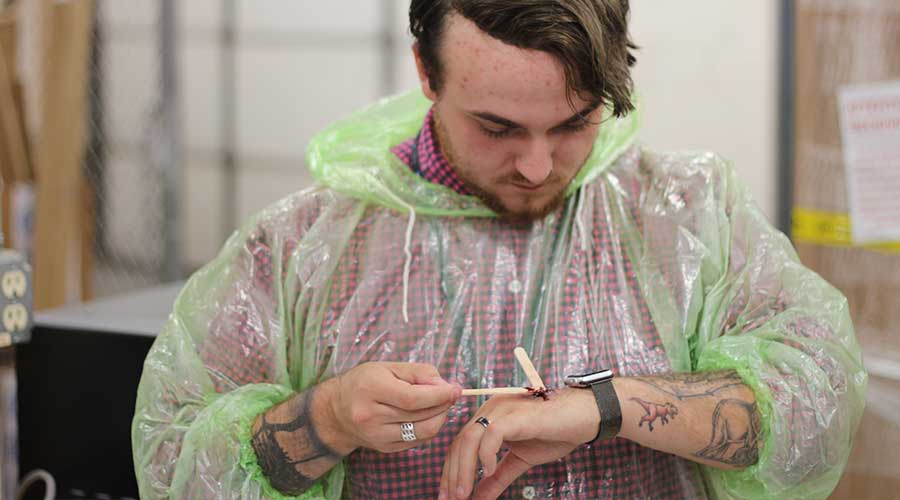
How to Create Realistic Moulage and Why It Matters
Every prank-loving adolescent knows all it takes is a little corn syrup and food coloring to whip up a batch of fake blood that will scare the pants off an unsuspecting mom, sibling or neighborhood friend. But recreating realistic wounds and injuries isn’t just for April Fools’ Day or Halloween. Special effects make up—or moulage—can also be an effective and affordable way to create realistic medical simulation scenarios that enhance and improve the learning experience.
WHAT IS MOULAGE?
The word moulage comes from a French word that refers to mold-making. In the world of medical simulation, moulage refers to anything from make-up to molds to artificial skin that helps you recreate a realistic wound, injury or symptom in a simulated scenario. Moulage can be applied both to standardized patients and manikins.
WHY SHOULD MOULAGE BE PART OF YOUR SIMULATION PROGRAM?
By now the benefits of realistic healthcare simulation training are well-documented. The challenge is how to create the most realistic scenarios possible with the time and budget constraints of your simulation program. Moulage is becoming a more common part of healthcare simulation programs to address this exact challenge. According to Maeve Geary, a UK-based special effects artist and PhD candidate studying “The evolving role of Special Effects as a component of Medical Simulation Engineering,” there are two types of scenarios where moulage can play a critical role.
- To cue a diagnosis or treatment decision. Something visual can quickly prompt a first responder or physician to make a diagnosis or recommend a course of treatment. For example, as part of a research position at Boston Children’s hospital, Geary was asked to create a gunshot wound, with both entrance and exit wounds, that could be applied to a pediatric manikin. The goal of the moulage, Geary said, was to allow the student to quickly identify that the bullet had gone through and wasn’t lodged in the patient— a realistic artificial wound made that possible. Creating bruises with make-up is another common moulage application. Because bruises change color over time, clinically accurate moulage bruises can help a student identify how long the bruises have been there, what kind of injury might have caused them and what next steps or course of treatment are required. Said Geary, “In these cases moulage really proves itself to be important.”
- To evoke an emotional response. One goal of medical simulation training is to provide hands-on experience with actual procedures in a controlled environment. Another is to help healthcare providers prepare emotionally for difficult cases in a low-risk setting. According to Geary, moulage plays an important role in that emotional preparation. Creating a lot of realistic blood and gore for a trauma scenario, for example, helps students understand what a real-life trauma would look like, and prepares them with the opportunity to manage their emotional and physiological response before there are actual lives on the line.
There are also scenarios where complicated and realistic moulage are not necessary. In a brain surgery simulation, time spent creating realistic head wounds and bruises would be wasted because the manikin’s head and shoulders would be covered up for the simulated procedure. “If it’s necessary for you to actually see something, or touch something, then you would be in the realm of moulage,” Geary said. Otherwise you don’t need it.
How can you get the most out of your moulage?
According to Geary, there are three factors to consider when deciding how to approach moulage: time, cost, and quality. In most cases, you have to pick the two most important. There is a sliding scale of realism, Geary added, and the balance will be different for every simulation program. But there are some ways to save money and still get life-like results. Silicone that might be used to create torn flesh is expensive, but you can get the same results by making gelatin. The recipe only requires ingredients you can find at a regular grocery store, and the gelatin can be melted down and used again. Bruising and wounds can also be applied to a nylon sleeve that you can slip on and off a manikin arm or leg, saving you time as you don’t have to recreate the same wound over and over. If you’re looking for more tips and tricks, Geary recommended the following resources:
- The book “Special Makeup Effects for Stage and Screen: Making and Applying Prosthetics” by Todd Debreceni
- The podcast “Battles with Bits of Rubber” featuring Todd Debreceni and Stuart Bray
- Neill Gorton’s 911 Facebook page
- The Prosthetics Magazine
Next Steps
In some cases, Geary said, the most cost-effective and time-efficient approach might be hiring an outside moulage expert for the scenarios that need it most, but it’s up to each sim tech and operations manager to decide what fits their program’s budget and needs best. The Level 3 Audiovisual simulation experts are always on hand to discuss any and all simulation-related questions. To get started, reach out to us here or click the chatbox below to connect instantly. We look forward to working with you.

